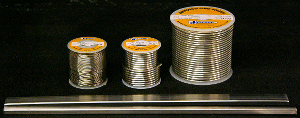| Alloy | Composition | Solidus°F | Liquidus°F | Shear PSI | Typical Uses |
|---|---|---|---|---|---|
| #IA-421 | Sn/3.8Ag/.7Cu(p) | 423 | 423 | 5091 |  |
| #IA-423 | Sn/4.7Ag/1.7Cu Ames Alloy(p)(e) |
423 | 423 | 5874 |   |
| #IA-425 | Sn/Ag/Cu SilverGloTM(p) | 423 | 423 |  |
|
| #460 | Sn/3.5Ag(e) | 430 | 430 | 5408 |   |
| #466 | Sn/4Ag | 430 | 444 |  | |
| #469 | Sn/5Ag | 430 | 464 |  | |
| #495 | Sn/Cu/.5Ag(p) | 437 | 660 | 4641 |  |
| (p) proprietary alloy | (e) eutectic alloy | ||||
IA-423 LEAD-FREE SOLDER
Tin-Silver-Copper, Ternary Eutectic Solder, Developed at AMES Laboratory, Iowa State University.
Johnson Manufacturing Company has licensed the rights to manufacture and sell solder developed by Ames Laboratory, on the campus of Iowa State University in Ames, Iowa. We refer to this, unique lead-free solder as "IA-423" (IA stands for Iowa, as well as for its inventor, while 423 is for its melting point).
Johnson's #IA-423 is a "ternary eutectic" alloy, i.e., a composition comprising its three component elements (tin, silver and copper) that both melts and flows at a single low temperature, 423°F (217°C). Practically speaking, eutectic alloys are shinier, stronger and have a tighter, more refined grain structure than near-eutectic or non-eutectic compositions. As a result, IA-423 and a family of its close relatives are becoming highly desirable replacements for the lead-containing solders used in electronic assemblies, printed circuit boards, copper foil stained glass work, aerospace, automotive, electrical, refrigeration and many other high-tech, or industrial soldering applications. Audiophiles also claim that #IA-423 is the best sounding solder they've ever heard, perhaps because of its high conductivity, owing to its high silver and copper content.
View our Technical Bulletin on this solder.
Read the Ames Laboratory Ring and Plug Shear Strength Test results for this and other alloys.
Silver Bearing Alloys, distinguished by their Silver Content (Ag) from 0.5 to 5.0%, offer high strength and excellent wettability.

Silver Bearing Solders, not to be confused with silver solders (brazing alloys), offer certain physical properties unsurpassed by other lead-free solders. With very few exceptions, they provide superior strength, wetability and corrosion resistance for soldering copper, brass, steel, etc., along with a good bond and color match with most grades of stainless. Aside from Johnson's #IA-423, ternary (3-element) tin-silver-copper eutectic alloy described above, similar alloys such as #IA-421, which contains less silver and copper, as well as #IA-425, the shiniest solder we've ever seen, (we call it SilverGloTM), provide subtle differences for certain heating methods, or soldering applications, etc.. These alloys, and a few others fall within what is referred to as a "narrow eutectic trough,".
Our most popular solder within the binary (2-element) tin-silver family of solders is Johnson's #460, which is a eutectic alloy that melts at 430 degrees F (221 C). To our knowledge, this is the only alloy that is acceptable for use when soldering food handling equipment. Johnson's #466 and #469 are both off-eutectic tin-silver alloys which offer melting ranges to benefit certain soldering applications.Johnson's #495 has the widest melting range of any silver bearing solder within our standard alloy offerings. Its primary use is for plumbing.